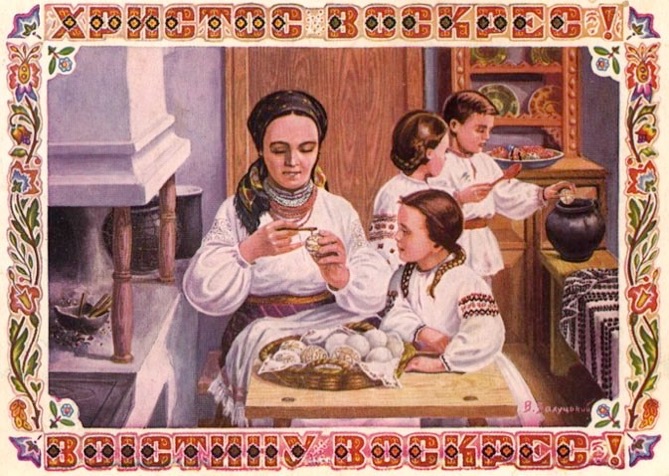Traditions:
Writing Pysanky
Traditions:
Writing Pysanky

Writing Pysanky
How was the wax applied?

The pysankarka would remove one stylus from the bowl, and write with it until the wax cooled; she would replace it into the bowl, and take another, and continue writing. This process would be repeated until she finished her design.
In the Lemko regions, where drop-pull pysanky were more common, the process was slightly different. The tip of the drop-pull stylus (pin or nail head) would be dipped into the wax, and then quickly touched to the egg, to create a round or tear-shaped drop of wax called a кривулька (kryvul’ka). These drops were arranged into flowers, suns, bands and other symbols on the shell of the egg.
How were the eggs dyed?
Pysanky were usually made in batches, rather than one at a time as many people do nowadays. Because dyeing times with natural dyes were so much longer than with modern aniline dyes (measured in hours rather than minutes), it was simpler to write and dye them in batches.
As in the painting shown above, all the white designs would be written onto a number of eggs. The eggs wold then all be placed into an earthenware jar with the first (usually gold or yellow) dye, and left to soak. When they were done dyeing, they would be removed, wiped with a soft cloth, and allowed to dry. The next set of designs would be written on the eggs and then they would be batch dyed the subsequent color. This would be repeated until the pysanky were done. Dyeing with natural botanical dyes was a often long process, with pysanky needing to soak from hours to even overnight.
Because of the long dyeing times of botanical dyes, color schemes of traditional pysanky were usually fairly simple. Two color eggs (white and a final color) were common, particularly among the Lemky, as were three and four color eggs. Eggs with complex color schemes were unusual.
The colors were not merely decorative, but were thought to have symbolic meanings:
Yellow–sunshine, warmth and hope
Green–nature and the hope of a good harvest
Blue–heaven and air, rivers and water
Red–life and health
Black–the earth that nourishes us all
Not merely pysanky, but even the cloth used to dry them, were thought to have magical powers. According to Voropay, this cloth would be hidden away, and used later to treat erysipelas (a streptococcal skin infection) by ”smoking” it out7.
How was the wax removed?
Once the eggs had been fully written, and the final dyebath was complete, the wax was removed. The pysanky would be placed in an earthenware bowl, and that bowl placed into a warm oven (35-40°C). The wax would slowly melt and flow off of the pysanka. A soft cloth would be used to wipe them clean.
__________
1.The cloth would be burned and the smoke used to fumigate erysipelas. This skin infection was nasty, and, in the pre-antibiotic era, it was not only difficult to treat, but could have nasty sequelae including endocarditis (infection of the heart valves), sepsis (blood poisoning), necrotizing fasciitis (“skin eating bacteria”) and death.
Back to Traditions home page
Back to MAIN Pysanka home page.
Back to Pysanka Index.
Search my site with Google
